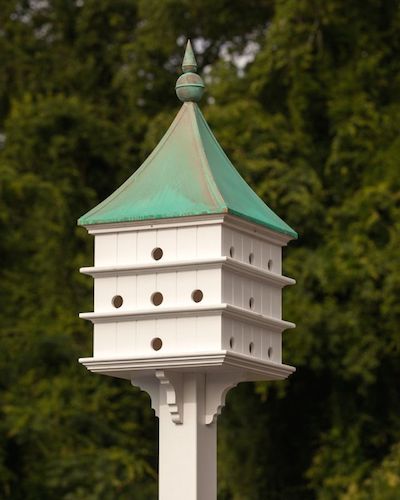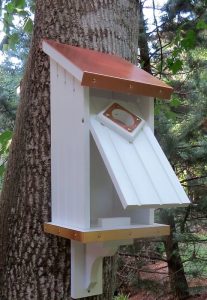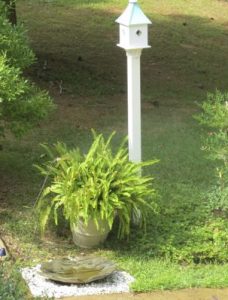-
Got Land? Copper Roof Birdhouses Set the Stage for Elegance
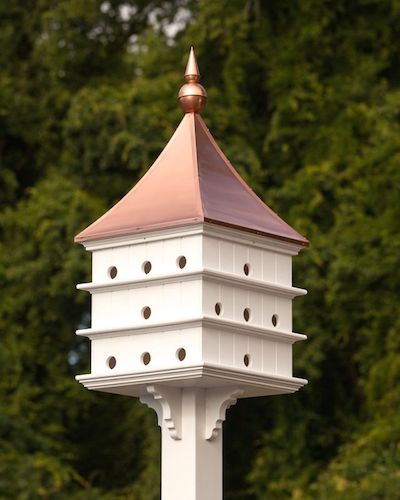
They’re our biggest and baddest vinyl birdhouses yet!Like Purple Martins, these large copper roof birdhouses require estate-size grounds, or at the very least- ample open space to showcase all of their majesty. Like building a giant house on a lot that’s too small, it will stand out like a sore thumb… and martin scouts will surely ignore theses fine accommodations.
Classic architectural style is both appealing and desired by many a home-owner. Some even ask us how to keep birds out? And that’s okay if you love the birdhouse but choose not to host birds. It’s far better to plug the holes than let dreaded, non-native house sparrows nest here.
Standing 54-inches tall, there’s pure elegance from tip of copper finial to bottom of vinyl/PVC mounting bracket. No wood is ever used in their construction, rendering them impervious to the elements and to insect damage. In short, these stately copper/vinyl birdhouses will never rot, warp, split or crack. To remove environmental build-up, take the garden hose right to them with mild soap and cloth.
Bright copper roofs remain shiny-new for at least 3 to 4 years prior to weathering. Because of special lacquer which preserves the newness, copper turns dark upon weathering and continues to do so. You won’t see the beautiful patina color because the copper is treated. Should the blue-green patina tickle your fancy, then that’s the way to go! It remains indefinitely with no weathering as this roof is crafted using an acid wash and heating process.
Closer to home (ours anyway) smaller size birdhouses with just as much elegance and detail are more common. New for 2017, there’s even a copper/vinyl bluebird house with lift-up door for easy monitoring. Ample ventilation and drainage keep babies cozy and nests dry. It also includes a vinyl mounting bracket suitable for post, fence or tree. You can bet we nabbed one of these for our own bluebirds!
The other birdhouse with 4 compartments, is a modest 10×10 that’s 28-inches tall. It’s hosted both nuthatches and chickadees simultaneously! So not only do our copper roof birdhouses look like wood, they come in small to estates sizes, and best of all… they’re bird-approved!
To learn more about using birdhouses and the problematic English house sparrow or European Starling, please check out Sialis.org for some some very useful, eye-opening info. Find trouble-shooting tips for hosting bluebirds and other native cavity dwellers.
-
Bluebird Houses, Meal Worms and Pesticides
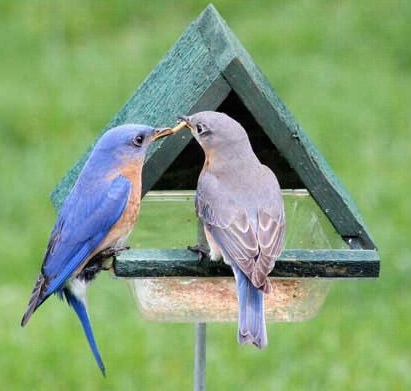 By the sound of the title alone, you gotta figure it can’t be good, but if the information educates just one person or raises awareness, then it’s well worth the time to write.
By the sound of the title alone, you gotta figure it can’t be good, but if the information educates just one person or raises awareness, then it’s well worth the time to write.Simply put: pesticides kill. Not only do they kill the targeted species, but affected prey also becomes poison (and fatal) for predator as well.
In a bluebird house along one monitor’s trail in a cemetery (yes, they’re great spots to host blues with open spaces and relatively limited activity) sat five eggs never to be incubated. Mom and dad who were healthy thriving parents were both found dead in the box, yet totally intact. This pair was actually banded and well known by local bluebird enthusiasts.
How does this connect to bluebird houses and meal worms? Pesticides… in the form of worm-shaped pellets! Mole baits resemble mealworms and when used properly should be placed below ground in the mole runs. Due to the inadvertent misuse of this poison by a cemetery employee, a slow and painful death came for both parents.
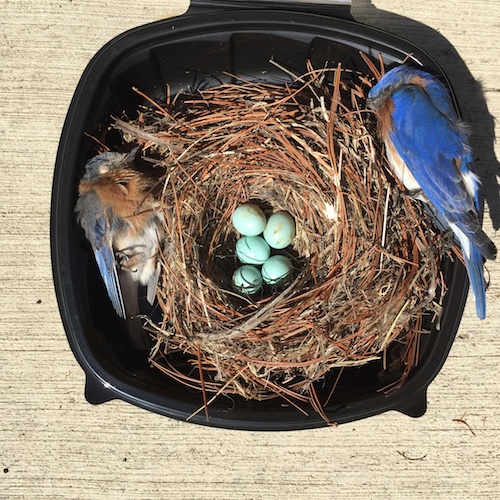
The incident occurred a few months ago. After the bait was carelessly disbursed, a sudden cold snap had the bluebirds believing these were worms. Paralyzed without a mark on them, both perished one day apart due to paralysis from the poison. Both had gone back to the bluebird house with eggs for their final breaths.
A bit dramatic? Maybe so, But step back and look at the big picture because in nature (and life) everything is connected. We’re killing ourselves, killing pollinators and killing Mother Earth. (this post was scheduled for Earth Day).
Stop using pesticides and chemicals. Manicured lawns and gardens are passe, natural and rustic are in style! If you’re trying to attract hummingbirds, butterflies or bees for instance, do not treat or spray flowers from which they draw nectar. Please be aware and mindful to help nature thrive in your patch of green… it’s for your own good!
Thanks Paula Z. of Ohio (dedicated bluebird monitor) for letting others know about this occurrence and use of the images.
“Sad occurrence in lone box in Powell Cemetery. Both male and female EABL were killed by Talpirid mole bait. We had extended cold snap and snow and desperate to find food, almost certainly found some “worms”. Male found dead in nestbox on 4-13 by me. He was in good physical shape without a mark on him. Female was in tree making some noise when I got there (maybe in pain, who knows?). I removed him and left her 5 eggs there. Following day, my friend checked box and found her dead in there too. I contacted city to find they had put down mole bait worms – almost certainly they found them, ate them or fed them to each other… Sad. I removed box for several days because a new pair was there checking out box same day we removed dead female – hope worms are out of the ecosystem by now. City won’t use poison worms again; will trap if they need to kill moles.
The dead male was banded in the nest on 7-1-13 in park that is maybe quarter mile from cemetery. This male was progeny of “Kamakazi Kent”, very aggressive male that hits me in the head at Village Green Park – no evidence of him nesting this year yet there, but he may no longer be with us as I know he nested there for past six years.”
-
Not So Decorative Birdhouses
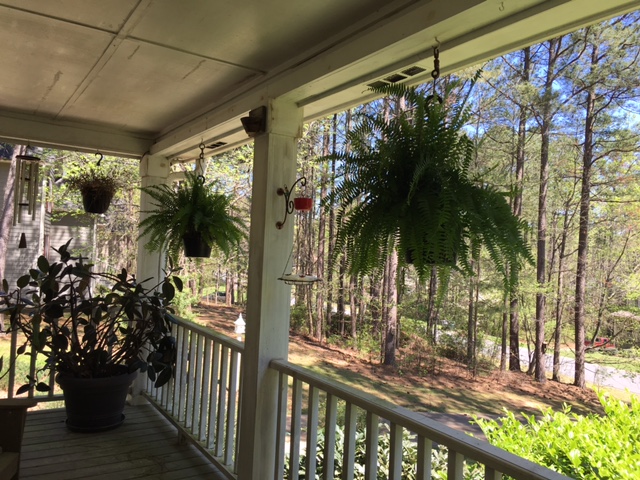 It’s a Spring Thing… rebirth, new growth and spring cleaning. While setting out a few new Boston ferns on the porch, the old ones lingered as winter shelter for birds. Upon inspection prior to tossing the plants, a nest with 5 tiny eggs. Hark… a Carolina wren decided to take up residence and rear her little ones in this not so decorative birdhouse. Rather unsightly after enduring through winter, the fern was moved a few feet to the end of the porch. Would she find it and continue to brood? Since most birds are pretty smart, chances were strong.
It’s a Spring Thing… rebirth, new growth and spring cleaning. While setting out a few new Boston ferns on the porch, the old ones lingered as winter shelter for birds. Upon inspection prior to tossing the plants, a nest with 5 tiny eggs. Hark… a Carolina wren decided to take up residence and rear her little ones in this not so decorative birdhouse. Rather unsightly after enduring through winter, the fern was moved a few feet to the end of the porch. Would she find it and continue to brood? Since most birds are pretty smart, chances were strong.Because Carolina wrens are known to nest in the craziest places, it’s a good idea (and highly recommended) to check old outdoor potted plants before tossing. Knick-nacks on the porch like baskets pots or vases should be checked for nest activity prior to cleaning, moving or discarding them as these sweet songbirds seem to prefer a closeness to their hosts.
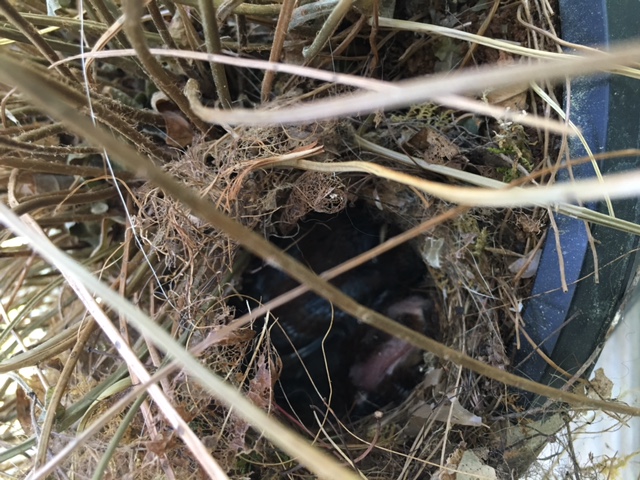 Fretting and watching for signs of mama, the plant was inspected a few days later to find the babies had hatched… success! Now it’s only a matter of days before the not so decorative birds’ home can be discarded. Not all birds use houses, and because nests are highly camouflaged in trees and shrubs, it’s a good idea to hold off pruning and major spring clean-up until fall.
Fretting and watching for signs of mama, the plant was inspected a few days later to find the babies had hatched… success! Now it’s only a matter of days before the not so decorative birds’ home can be discarded. Not all birds use houses, and because nests are highly camouflaged in trees and shrubs, it’s a good idea to hold off pruning and major spring clean-up until fall.Offering safe places to nest for those who are cavity dwellers helps species thrive.Wooden bird houses are always a good bet, as are vinyl and ceramic. Metal is questionable as afternoon sun could bake nestlings if not protected by shade. Ventilation and drainage are important factors in keeping babies dry and comfy too.
Cool birdhouses like this moss and wicker number are handmade of materials birds already know, it’s perfect on the porch or any protected area for a natural yet whimsical touch. Wooden houses needn’t be boring either, just properly sized with bird-friendly features and sturdiness to raise the kids. Happy Spring!

